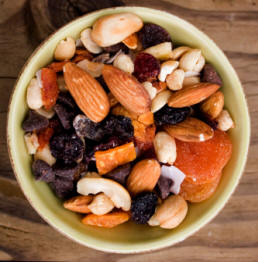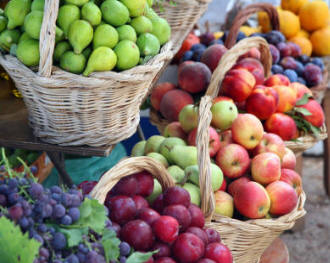Summer 2009: To Your Health
In this Issue:
- Keep your Skin Healthy from the Inside Out!
- Celebrate National Men’s Health Week
- Proper Hydration During the Summer Months
- Enjoy Trail Mix Day this August, but Beware of Fat Traps!
- Freshen Up this Summer with some Tasty Fruits and Veggies
- Feature Food of the Month: Quinoa
- Recipe of the Month: Quinoa and Asparagus Salad
Keep your Skin Healthy from the Inside Out!

In this day and age, many people are not only concerned with their health, but also their looks. In such an aesthetics-worshipping world, healthy looking skin is a definite desire amongst most of the population. What most people don’t know is that beautiful, radiant skin is not always found in a little glass jar—it’s found within! Healthy skin and good nutrition go hand-in-hand. While it’s impossible to prevent the aging process of your skin, consuming nutritionally sound meals can lead you to a more glowing and healthy complexion.
Worried about wrinkles? Start getting friendly with fish.
- Omega-3 Fatty Acids: Wild salmon, sardines, Atlantic mackerel and herring are great sources of omega-3 fatty acids, which have been shown to improve circulation and decrease inflammation. Inflammation has potential to cause damage to the collagen in your skin, leading to wrinkles.
- Vitamin C: In addition to fatty acids, vitamin C can play a large role in keeping your skin smooth. It is responsible for collagen production and healthy skin maintenance. Research has shown that an increased intake of vitamin C was linked to a decrease in wrinkles. Vitamin C can be included in your daily diet by consuming bell peppers, broccoli, cauliflower, and leafy greens. In addition, the American Academy of Dermatology deems 500-1,000 milligrams of a vitamin C supplement daily safe. Note: Check with your physician before taking supplements. Supplements may interfere with certain medications and/or may not be appropriate in certain medical conditions.
Scared of the sun’s harmful rays? Well, there’s still no such thing as safe sun bathing, but if you want a little more protection, try to increase your daily dose of vitamins C and E. A study done in 2005 found that those who took these vitamins long-term had a reduced incidence of sunburn from UVB rays. It has been shown that sunlight can cause free radical production in the skin, causing collagen and elastin destruction. Vitamins C and E may help stop this damage. Food sources high in vitamin C include oranges, guava, red pepper, kiwi, grapefruit strawberries and brussel sprouts. Food sources of vitamin E include fortified cereal, sunflower seeds, nuts, wheat germ and avocado.
Wondering how to get overall great skin? Vitamin A plays an important role when it comes to keeping your skin looking great. Most dietary vitamin A comes from beta-carotene, an antioxidant that converts to vitamin A in your body. This nutrient keeps your skin smooth, and controls your sebum (oil) levels. Food sources high in beta-carotene include carrots, pumpkin, sweet potato, spinach, collards, kale, turnip greens, beet greens, and winter squash
Want dewy moisturized skin? Look for B vitamin complexes. Niacin, a B vitamin, helps the skin retain moisture, plus it has anti-inflammatory properties to help with dry or irritated skin. Foods high in protein are highest in niacin. These foods include lean meat, liver, fish, poultry, eggs, legumes, peanut butter as well as enriched cereals. To get your daily dose of all the B vitamins, eat a variety of foods such as turkey, liver, tuna, chili peppers, lentils, bananas, potatoes, and tempeh (soy-based). In addition, molasses and brewer’s yeast are good sources of the B vitamins.
Generally, a daily multivitamin can provide all the skin nutrition you may need, but you can also find these nutrients in foods and topical creams. If you feed your skin correctly, you can keep it looking its best!
Celebrate National Men’s Health Week June 15-21, 2009

National Men’s Health Week is celebrated each year as the week leading up to and including Fathers Day. This year, the focus is on increasing awareness of preventable health issues affecting men today. This week gives health care providers and the public at large an opportunity to encourage men and boys to seek regular medical advice and get screened for early detection of common diseases amongst the male population.
Did you know that heart attacks are the single biggest killers of American males?
In an effort to reduce heart-related complications, “Meatless Mondays” has been created as a part of Men’s Health Week. Dietary fats, such as saturated fats and trans fats, are one of the many preventable factors attributed to heart attacks and heart disease. Most meats are high in saturated fats and cholesterol, major contributors to heart disease, high blood pressure, and stroke. The goal of this fantastically fun day is to help Americans reduce their consumption of saturated fats by 15% by the year 2010. Consuming saturated fats increases your “bad” cholesterol levels (LDL cholesterol), in turn increasing your risk for cardiovascular disease. The “Meatless Mondays” campaign does not actually encourage vegetarianism, but is about significantly cutting down on those harmful fats on that particular day (Mondays) by eliminating its major food sources. This in turn will hopefully result in a healthier intake for the remainder of the week. Eating a diet low in saturated fats is not only good for you, it can be tasty and delicious too!
There are many ways for you to get your daily protein needs without the high-fat steak or hamburger. Try the following options:
- Tofu or other soy-based products are good alternatives to add to your once “meat meal”. Chili can still be included in your weekly meals by using a soy-based vegetarian chili substitute that is just as delicious and a whole lot healthier than its meat alternative.
- Beans are a great meat substitute. Take your meat and temporarily slide it over for the day and bring in the beans! Beans are a hardy and filling meat alternative that provides a great texture and taste to any dish. In addition, they add a load of fiber to your meal and can be easily pureed into a bean soup, or added to a nice tasty salad.
- Other variations of vegetable proteins include lentils, nuts, and seeds. These replacements provide a nice amount of protein and even contribute to your daily fiber needs. These alternatives can be used as your main ingredient, or can be incorporated into a delicious side dish.
If you can’t find any vegetarian options that spark your taste buds, consider fish instead of your usual red meat choice. Certain fatty fish offer a hearty helping of omega-3 fatty acids, which have been linked to a decreased risk of cardiovascular disease. Aim for 2 servings of fatty fish per week, such as salmon, mackerel, lake trout, herring, sardines, and albacore. Heart health is simple to maintain as long as you eat right and keep your heart in tip top shape!
Click here for additional heart healthy nutrition guidelines.
Proper Hydration During the Summer Months

As those hot summer days creep up upon you, you must not forget a small yet highly important task: staying hydrated! Fueling up with some good old fashioned H20 will help prevent dehydration and any related complications. The human body is made up of approximately 60-75% water, so staying hydrated throughout the day really “does a body good.” Not to worry, though, if you’d rather think about those nice strappy sandals you saw at the mall instead of thinking about water, your body will naturally signal you to drink when fluids are needed. Ignoring your body’s cues can lead to dehydration, with symptoms ranging from mild to life-threatening.
Dehydration occurs when you lose more water than you take in, either through breathing, sweating, or excretion. So how much water do you actually need? Women require about 9 cups of water each day, while men need about 12 cups. Don’t get discouraged if you feel like you don’t meet these requirements. Many foods have a surprisingly high water content to help keep you properly hydrated. Watermelon contains 97% water, hence the name, though other less obviously named fruits and vegetables contain a significant amount of water. Cucumbers contain 97% water, while tomatoes and zucchini have a slightly lower but still impressive water content (95%). Eggplant and peaches are also good thirst quenchers, with eggplant falling in at 92% and peaches at 87%.
There are some foods with significant amounts of water that appear to possess none. Beans, grains, and pasta all absorb water during the cooking process, and hold on to it to deliver more fluids to you throughout the day. One cup of red kidney beans has 77% water, and one cup of couscous holds around ½ cup of water.
Even though these foods certainly help in staying hydrated, it is still important to drink water throughout the day. If you’re in the heat for an extended period of time, watch out for signs of dehydration, such as if you stop sweating, or producing tears, cramps start to occur, you feel thirsty or you start to feel nauseous or begin to vomit. If you experience any of these symptoms, remove yourself from the heat to cool down, and slowly begin drinking more water to re-hydrate. Re-hydrating is very important as soon as you experience symptoms in order to prevent any further serious complications. Be sure to call your doctor if you experience any of the above symptoms.
Find water a bit too boring? Click here for some healthy ways to jazz up your water.
Enjoy Trail Mix Day this August, but Beware of Fat Traps!

Trail Mix Day is August 30, 2009!
Trail mix, a once known “hippie” food, is making a huge comeback and everyone is talking about it. In case you have not read up on what a trail mix consists of, this delicious food mix is a combination of dried fruit, grains, nuts, and sometimes chocolate. It was originally developed as a snack food to be taken along on hikes, ideally because it is lightweight, easy to store, and nutritious, providing a quick boost from the carbohydrates in the dry fruit and granola, and sustained energy from the mono-and polyunsaturated fats in the nuts.
While some healthy snacks are certainly an acquired taste, trail mix has a widespread appeal to adults and kids. While choosing to snack on a trail mix over those greasy potato chips in the back of your cabinet is no doubt a better choice, don’t be fooled by the “healthy components” trail mixes have. While nuts, dried fruits, and grains are healthy options, it’s best to enjoy them in moderation. And by moderation we mean one handful will do. Most forms of granola or trail mix are high in fat or calories (even though they do contain “good” fats), and may interfere with losing or maintaining body weight when overeaten. Most commercial trail mixes consider ¼ cup to be a typical serving, which is not a whole lot of mix. Portioning out the correct serving size is the “healthier” way to eat this “healthy” snack item.
To make sure you’re eating a trail mix that is wholesome and on track with your caloric goals, try creating your own homemade mix. Here are some tips that will help you choose a healthier trail mix:
- Shop around for granola that is low in fat and calories, and keep track of serving sizes. Keep in mind that any dried fruit or nuts you may want to include in your mix come with high calorie counts.
- Try adding in some antioxidant rich dried berries, such as dried acai berries or dried blueberries.
- For an even healthier version of the trail mix, try buying dried fruits with no additional sugar added, or even include some raw nuts with no additional salt or fats.
- Adding soybeans as a replacement for sugary sweets, like chocolate, is a great choice that will deliver a crunchy taste, extra protein for energy, and way less fat!
With these simple considerations, you can make your own tailor-made trail mix, and still stay on track with your health goals!
For a tasty, healthy trail mix recipe visit our special web section.
Freshen Up This Summer with Some Tasty Fruits and Veggies

“Eat your fruits and vegetables” is one of the tried and true recommendations for a healthy diet. The fruits and vegetables of summer are just heavenly…peaches, nectarines, apricots, and more! Summer is the perfect time for a fresh garden salad, pasta salad with veggies, or veggies dipped into a nice cool dip. Fruits and vegetables contain essential vitamins, minerals, and fiber that may help protect you from chronic diseases. A growing body of research proves that fruits and vegetables are critical to promoting good health. In fact, fruits and vegetables should be the foundation of a healthy diet. Eating plenty of fruits and vegetables can help ward off heart disease, stroke, control blood pressure, prevent some types of cancer, and may guard against macular degeneration.
June Fruits and Veggies in Season:
Okra: Okra is a fuzzy, green colored and ribbed pod that is about 2-7 inches long. Commonly grown in the southern states, okra is commonly associated with Southern, Creole, and Cajun cooking styles. Nutritionally, okra ranks high as a valuable source of vitamin C. This low in calorie and fat-free veggie comes in many varieties, ranging from dark green in color (Clemson, Emerald, and Chinese Okra) to the bright greens (Annie Oakley, and Lee). Okra is available as frozen or fresh. When buying okra, make sure to select the dry, firm, blemish free ones. Fresh okra should typically be used on the same day as purchased or stored in a paper bag in the refrigerator for 2-3 days. Very cold temperatures will speed up the ripening process and decay of okra. When preparing, remember to only wash the pods right before use in order to avoid the okra from becoming slimy. Commonly used as a thickening agent, okra is a great addition to thicken up any soups and stews due to its slimy nature. However, okra may also be boiled, steamed, pickled, sautéed, or stir fried whole. Be careful when choosing your pan to cook the okra in; they are very sensitive vegetables. Pans made from iron, copper, or brass should not be used for cooking okra since their chemical properties will turn the okra black!
Tip: To reduce some of the okra slime, trim the ends off and try to avoid puncturing the okra capsule. In addition, avoid overcooking the okra.
Pluots and Apriums: Pluots are hybrid fruits that are part plum and part apricot. Often confused with the aprium (another plum and apricot combo, though consists of mostly apricot), the pluot is mostly plum in heritage and therefore has a smooth skin like a plum. Pluots and apriums are very sweet, containing a higher sugar content than the plum or apricot fruit alone.
When selecting these fruits, choose a plump and firm fruit. Avoid pluots that are green, blemished, or have broken skin. Pluots and apriums should be ripened at room temperature and then refrigerated. Pluots may be ripened in a brown paper bag at room temperature. When ready to eat, wash and dry and you are ready to go!
July Fruits and Veggies in Season:
Nectarines: Similar to the peach, nectarines are smaller and smooth skinned, and golden yellow in color with large blushes of red. Identifying a nectarine is simple—it lacks the fuzz of a peach! With over 100 varieties, nectarines are low in calories with no sodium or cholesterol. Half a cup of this delicious fruit provides only 30 calories and 1 gram of fiber!
Ripe nectarines are fragrant and give slightly to the touch. Any under ripened fruit can be ripened at room temperature for 2-3 days. Avoid purchasing bruised, hard or dull colored nectarines. A sensitive fruit, they must be stored in the coldest part of the fridge in a plastic bag. Leave the skin on when making cobblers, pies, fresh fruit salads, and more.
Garlic: In ancient times, garlic was believed to have had strong medicinal properties. Even in modern times, garlic is still being promoted as a healing vegetable. Characterized by its strong flavor and smell, garlic is a great flavoring to add to a variety of dishes.
Garlic is available fresh or frozen year round, though it is at its freshest during the summer months. When choosing garlic, avoid soft, mushy, or shriveled cloves. Garlic should be stored in a cool, dark place (not a refrigerator), and can be kept for several weeks. Small clay garlic holders are available to keep the garlic fresh. If you catch a clove with a green sprout hanging off it, don’t worry, the clove can still be used but the flavor may not be as strong. In fact, the sprouts themselves can be cut up like scallions and chives and used as a flavoring. When preparing garlic, remove the individual garlic cloves, peel the outer layers from the bulb and snap out each clove from the base. To add a strong garlic flavor to your dish, use chopped, crushed, pressed or pureed garlic. The more finely chopped, the stronger the flavor. For a milder flavor, whole cloves can be added to food while it cooks, and thrown away before serving. In addition, cooking the garlic decreases the strength of its flavor—the longer it cooks, the milder it gets.
Tip: To remove garlic odor from hands, use salt or lemon juice and then wash hands with soap.
August Fruit and Veggies in Season:
Cactus: Edible cactus, also known as nopales, is a very popular vegetable in Mexico. It contains fleshy oval leaves (known as the pads) with a soft but crunchy texture. The cactus has a tendency to become a bit sticky when cooked, and tastes similar to slightly tart green beans, asparagus, or green peppers. Edible cactus is actually a pretty nutritious vegetable containing beta carotene, iron, some B vitamins, and are good sources of both vitamin C and calcium. Choosing edible cactus as part of a nutritious diet is a great choice since it is an extremely low calorie and fat-free vegetable. Edible cactus are sold as canned, fresh, and acitrones (candied cactus, packed in sugar syrup; available in cans or jars).
Tip: When buying edible cactus, choose small, firm, pale green cacti with no wrinkling. The cactus should be de-spined, though you may need to trim the “eyes” to remove any remaining prickers. Trim off any dry areas and rinse thoroughly to remove any stray prickers and sticky fluid. The best of the process, eating the cactus, can be done raw or cooked. To cook, steam over boiling water for a few minutes (if cooked too long, they’ll lose their crunchy texture), slice and eat! Steamed cactus can be added to scrambled eggs and omelets, or diced fresh and added to tortillas.
Figs: While most consider the fig to be a sweet tasty snack (the Fig Newton), the fig is considered to be a fruit, though it is actually a flower inverted into itself. They are the only fruit that will ripen on the tree. There are hundreds of varieties of figs, though the Calimyrna Fig, Mission Fig, Kadota Fig, and Brown Turkey Fig are most commonly found in supermarkets. This highly nutritious fruit is packed with vitamin C, fiber, and vitamin A. When selecting fresh figs, look for ones that are soft and smell sweet. Handle them carefully because they are a very fragile fruit and can bruise easily. Fully ripened figs can be stored in the fridge for up to 2 days.
Tip: Figs can be used as a replacement for fat in your recipes. Choose the dried version and be careful NOT to overmix or overcook. Use only half the normal amount of shortening, margarine, butter, or oil in a recipe when using dried puree figs. For example, if a recipe calls for 1 cup of oil, use only ½ cup oil and ½ cup fig puree.
Consuming your daily fruits and vegetables is a great way to stay healthy. To make sure you are on the right track, click here for some fruit and veggies do’s and don’ts.
Feature Food of the Month: Quinoa

Quinoa is a type of seed that is related to beets, chard, and spinach. A relatively new seed to the United States, Quinoa has been cultivated for over 5,000 years in the Andean mountains in Peru, Chile, and Bolivia. In ancient civilizations it was regarded as a very important food. The Incas referred to it as the “mother seed,” considering it a sacred food, because its high protein content increased the stamina of their warriors. Quinoa is considered a complete protein, meaning it contains all nine essential amino acids. (histidine, isoleucine, leucine, lysine, methionine, phenylalanine, threonine, tryptophan, and valine). Lysine, an amino acid essential for tissue growth and repair, is normally lacking in most grains, though in quinoa’s case it completes the protein content. Quinoa is also known as a good source of manganese, magnesium, iron, copper, and phosphorus.
This nutritious and delicious seed may have been around for quite a while, but it only recently appeared in America during the 1980’s, cultivated in Colorado. It is now gaining in popularity due to its excellent nutrient content and amazing versatility. Cooked quinoa can be combined with beans, other seeds, nuts, and fruits for a delightful twist. Quinoa flour can also be used in combination with wheat flour to turn your usual baked goods into a healthy treat. Cooked quinoa seeds have a fluffy, creamy texture, yet are slightly crunchy, with a somewhat nutty flavor. The most popular variation of this seed has a transparent yellow color, but can also come in orange, pink, red, purple, or black.
When purchasing quinoa, whether in bulk or in prepackaged containers, make sure there is no evidence of moisture, to ensure maximum freshness. Also keep in mind that this seed expands to several times its raw size when cooked, so measure your quinoa correctly when using in recipes. When storing quinoa, place in an airtight container to prevent moisture buildup leading to spoilage. Quinoa can be refrigerated to extend its shelf life for 3 to 6 months.
To prepare quinoa, thoroughly wash the seeds, removing any saponin residue. An effective cleaning method is to place quinoa seeds in a mesh strainer and run cold water over it, gently rubbing the seeds together. When ready to cook, add one part seeds to two parts liquid in a saucepan and bring to a boil. Once it has reached boiling, reduce to a simmer and cover. One cup of quinoa usually takes about 15-20 minutes to prepare with this method. Once it’s fully cooked, the grains will look translucent. Now you’re ready to enjoy and reap its nutritional benefits!
Healthy Recipe – Quinoa and Asparagus Salad
Ingredients:
2 cups fat free, low sodium chicken broth
1 cup quinoa, dry
8 asparagus spears
4 tbsp. lemon juice
Dill, fresh, to taste
2 garlic cloves, crushed
2 tbsp. olive oil
Pepper to taste
Instructions:
- Bring broth to a boil; add quinoa.
- Steam asparagus for 4 minutes, then rinse in cold water
- Mix lemon juice, dill, garlic and olive oil.
- Toss asparagus, quinoa, and dressing in a bowl.
- Add pepper to taste.
Yield: 4 servings
Serving Size: ½ cup
Exchanges: 2 starch, 1 ½ fat
Nutrition Facts:
Calories: 233
Total Fat: 9 grams
Monounsaturated fat: 6 grams
Polyunsaturated fat: 2 gram
Saturated fat: 1 gram
Cholesterol: 0 milligrams
Protein: 8 grams
Carbohydrate: 30 grams
Sodium: 34 milligrams
Dietary Fiber: 4 grams
For more healthy recipes, click here.

Leave a Reply
Want to join the discussion?Feel free to contribute!